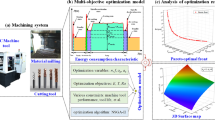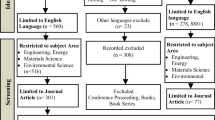Abstract
Milling force, closely related to machining efficiency and machining quality, is the most important technical parameter in computer numerical control machining. Aiming at five-axis flat-end milling, this paper proposes a milling force prediction model with arbitrary feed direction and cutter workpiece engagement (CWE). CWE, defining the interaction region between cutter and workpiece, is the basis for studying statics and dynamics of cutting. The efficiency of traditional solid modeling method is low and not suitable for large complex sculptured surface. Z-map method is also difficult to apply in five-axis flat-end milling. In response to this issue, analytic CWE model for five-axis flat-end milling of inclined plane is established by calculating the intersection of spatial surfaces; then, an algorithm is proposed to investigate the in-cut cutting edge. Different from the conventional slot cutting and half slot cutting processing, non-slot cutting processing with changing arbitrarily of cutter axis direction is used to calibrate the coefficients which are more suitable for five-axis machining. Combined with the instantaneous chip thickness considering cutter run-out, the cutting force coefficients which have quartic polynomial relationship with instantaneous chip thickness and the cutter run-out parameter identification model are established. The validity of this analytic model has been proved by experimental tests. The results also show that the measured milling force and predicted milling force are in good agreement in the aspect of the amplitude and trend in the different cutting depth, path interval, feed per tooth, and slope inclination angle, which verifies the efficiency of the coefficient identification model.
Similar content being viewed by others
References
Altintas Y, Spence AD (1994) A solid modeler based milling process simulation and planning system. J Eng Ind-T ASME 116(1):61–69
El-Mounayri H, Spence AD, Elbestawi MA (1998) Milling process simulation-a generic solid modeller based paradigm. J Manuf Sci Eng-T ASME 120(2):213–221. https://doi.org/10.1115/1.2830116
Yip-Hoi D, Huang XM (2006) Cutter/workpiece engagement feature extraction from solid models for end milling. J Manuf Sci Eng-T ASME 128(1):249–260. https://doi.org/10.1115/1.1948395
Ferry W, Yip-Hoi D (2008) Cutter-workpiece engagement calculations by parallel slicing for five-axis flank milling of jet engine impellers. J Manuf Sci Eng-T ASME 130(5):383–392
Yang Y, Zhang WH, Wan M, Ma YC (2013) A solid trimming method to extract cutter-workpiece engagement maps for multi-axis milling. Int J Adv Manuf Technol 68(9–12):2801–2813. https://doi.org/10.1007/s00170-013-4876-2
Choi BK, Kim DH, Jerard RB (1997) C-space approach to tool path generation for die and mould machining. Comput Aided Des 29(9):657–669. https://doi.org/10.1016/S0010-4485(97)00012-2
Fussell BK, Jerard RB, Hemmett JG (2003) Modeling of cutting geometry and forces for 5-axis sculptured surface machining. Comput Aided Des 35(4):333–346. https://doi.org/10.1016/S0010-4485(02)00055-6
Li JG, Ding JA, Gao D, Yao YX (2010) Quadtree-array-based workpiece geometric representation on three-axis milling process simulation. Int J Adv Manuf Technol 50(5–8):677–687. https://doi.org/10.1007/s00170-010-2530-9
Aras E, Feng HY (2011) Vector model-based workpiece update in multi-axis milling by moving surface of revolution. Int J Adv Manuf Technol 52(9–12):913–927. https://doi.org/10.1007/s00170-010-2799-8
Wei ZC, Wang MJ, Cai YJ, Wang SF (2013) Prediction of cutting force in ball-end milling of sculptured surface using improved Z-map. Int J Adv Manuf Technol 68(5–8):1167–1177. https://doi.org/10.1007/s00170-013-4909-x
Qiu W, Liu Q, Yuan S (2015) Modeling of cutting forces in orthogonal turn-milling with round insert cutters. Int J Adv Manuf Technol 78(5–8):1211–1222. https://doi.org/10.1007/s00170-014-6742-2
Bailey T, Elbestawi MA, El-Wardany TI, Fitzpatrick P (2002) Generic simulation approach for multi-axis machining, part 1: modeling methodology. J Manuf Sci E-T ASME 124(3):624–633. https://doi.org/10.1115/1.1468863
Ozturk B, Lazoglu I, Erdim H (2006) Machining of free-form surfaces. Part II: calibration and forces. Int J Mach Tool Manu 46(7–8):736–746. https://doi.org/10.1016/j.ijmachtools.2005.07.037
Kline WA, Devor RE, Lindberg JR (1982) The prediction of cutting forces in end milling with application to cornering cuts. Int J Mach Tool Des Res 22(1):7–22. https://doi.org/10.1016/0020-7357(82)90016-6
Wang JJJ, Chang HC (2004) Extracting cutting constants via harmonic force components for a general helical end mill. Int J Adv Manuf Technol 24(5–6):415–424. https://doi.org/10.1007/s00170-003-1664-4
Zhang ZH, Zheng L, Zhang L (2005) A study on calibration of coefficients in end milling forces model. Int J Adv Manuf Technol 25(7-8):652–662. https://doi.org/10.1007/s00170-003-1903-8
Dotcheva M, Millward H, Lewis A (2008) The evaluation of cutting-force coefficients using surface error measurements. J Mater Process Technol 196(1-3):42–51. https://doi.org/10.1016/j.jmatprotec.2007.04.136
Powalka B, Dhupia JS, Ulsoy AG, Katz R (2008) Identification of machining force model parameters from acceleration measurements. Int J Manuf Res 3(3):265–284. https://doi.org/10.1504/IJMR.2008.019210
Kline WA, Devor RE (1983) The effect of runout on cutting geometry and forces in end milling. Int J Mach Tool Des Res 23(2-3):123–140. https://doi.org/10.1016/0020-7357(83)90012-4
Wang JJJ, Liang SY (1996) Chip load kinematics in milling with radial cutter runout. J Eng Ind Trans ASME 118(1):111–116. https://doi.org/10.1115/1.2803631
Wan M, Zhang WH, Tan G, Qin GH (2007) New algorithm for calibration of instantaneous cutting-force coefficients and radial run-out parameters in flat end milling. Proc Inst Mech Eng B J Eng Manuf 221(6):1007–1019. https://doi.org/10.1243/09544054JEM515
Wan M, Zhang WH, Qin GH, Tan G (2007) Efficient calibration of instantaneous cutting force coefficients and runout parameters for general end mills. Int J Mach Tool Manu 47(11):1767–1776. https://doi.org/10.1016/j.ijmachtools.2006.06.012
Yun WS, Cho DW (2000) An improved method for the determination of 3D cutting force coefficients and runout parameters in end milling. Int J Adv Manuf Technol 16(12):851–858. https://doi.org/10.1007/s001700070001
Wan M, Pan WJ, Zhang WH (2014) A unified instantaneous cutting force model for flat end mills with variable geometries. J Mater Process Technol 214(3):641–650. https://doi.org/10.1016/j.jmatprotec.2013.10.016
Shirase K, Altintas Y (1996) Cutting force and dimensional surface error generation in peripheral milling with variable pitch helical end mills. Int J Mach Tools Manuf 36(5):567–584. https://doi.org/10.1016/0890-6955(95)00063-1
Zheng L, Chiou YS, Liang SY (1996) Three dimensional cutting force analysis in end milling. Int J Mech Sci 38(3):259–269. https://doi.org/10.1016/0020-7403(95)00057-7
Lee TS, Lin YJ (2000) A 3D predictive cutting-force model for end milling of parts having sculptured surfaces. Int J Adv Manuf Technol 16(11):773–783. https://doi.org/10.1007/s001700070011
Liu XW, Cheng K, Webb D, Luo XC (2002) Prediction of cutting force distribution and its influence on dimensional accuracy in peripheral milling. Int J Mach Tools Manuf 42(7):791–800. https://doi.org/10.1016/S0890-6955(02)00016-0
Tsai CL (2007) Analysis and prediction of cutting forces in end milling by means of a geometrical model. Int J Adv Manuf Technol 31(9–10):888–896. https://doi.org/10.1007/s00170-005-0275-7
Wan M, Lu MS, Zhang WH, Yang Y (2012) A new ternary-mechanism model for the prediction of cutting forces in flat end milling. Int J Mach Tools Manuf 57:34–35. https://doi.org/10.1016/j.ijmachtools.2012.02.003
Altintas Y (2000) Manufacturing automation: metal cutting mechanics, machine tool vibrations, and CNC design. Cambridge University Press, Cambridge, United Kingdom
Funding
This research is supported by the Natural Science Foundation of Liaoning No. 201602174 and the Fundamental Research Funds for the Central Universities No. DUT17GF213.
Author information
Authors and Affiliations
Corresponding author
Rights and permissions
About this article
Cite this article
Wei, Z.C., Guo, M.L., Wang, M.J. et al. Prediction of cutting force in five-axis flat-end milling. Int J Adv Manuf Technol 96, 137–152 (2018). https://doi.org/10.1007/s00170-017-1380-0
Received:
Accepted:
Published:
Issue Date:
DOI: https://doi.org/10.1007/s00170-017-1380-0




